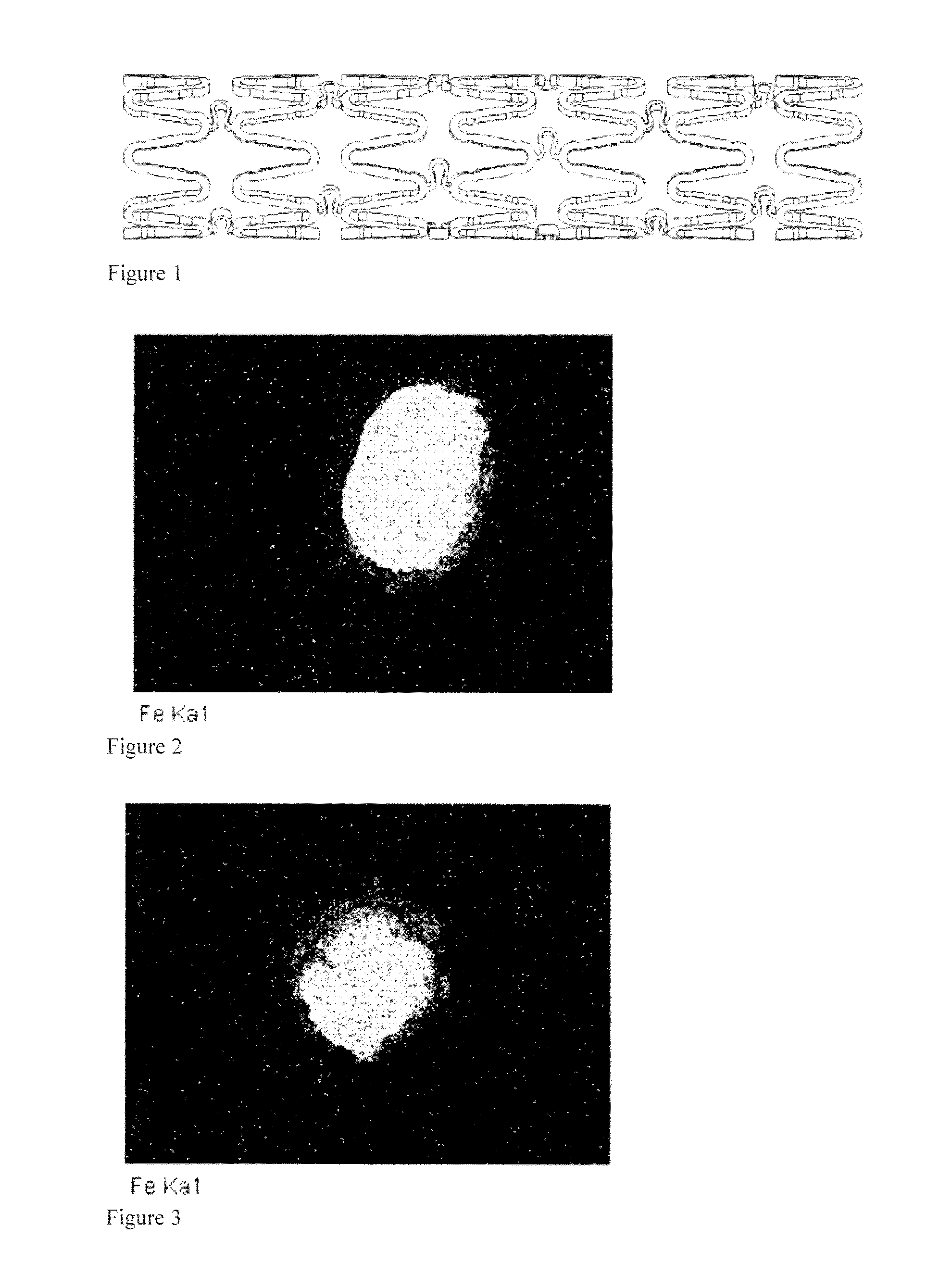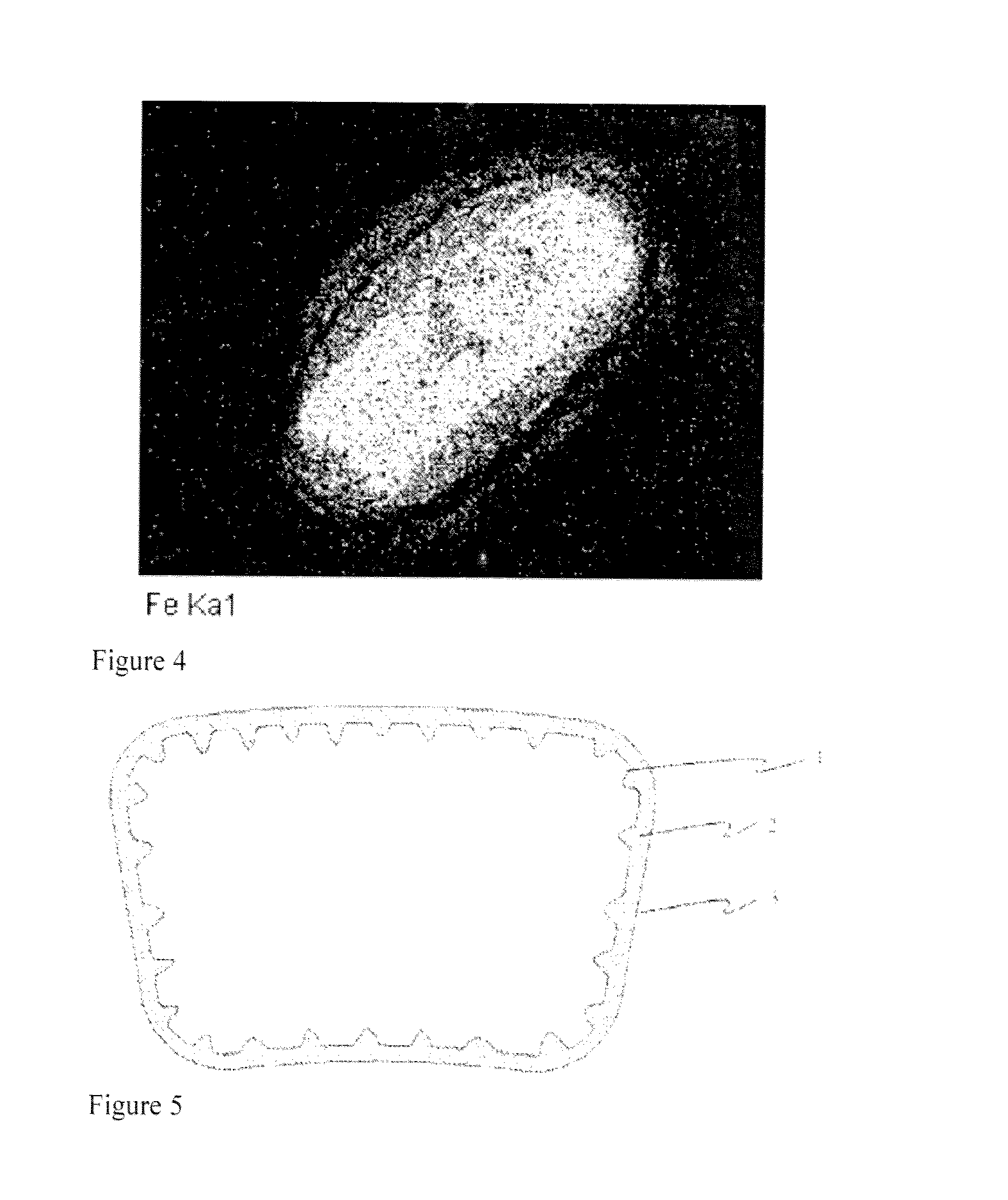Bioresorbable Iron-Based Alloy Stent
a technology of iron-based alloy stents and bioresorbable materials, which is applied in the direction of prosthesis, surgery, coatings, etc., can solve the problems of unfavorable further metabolism and absorption of iron, slow corrosion rate of pure iron, and need to be accelerated
- Summary
- Abstract
- Description
- Claims
- Application Information
AI Technical Summary
Benefits of technology
Problems solved by technology
Method used
Image
Examples
example 1
[0062]The surface of a nitrided pure iron stent with a stent strut of which the thickness is between 60 μm and 70 μm was completely coated with a poly (DL-lactic acid) coating with a thickness of between 8 μm and 15 μm, a weight average molecular weight of 50,000 and a polydispersity index of 2 to obtain an absorbable iron-based alloy stent after drying. The iron-based alloy stent was implanted into the abdominal aorta of a rabbit. The stent was taken out at a corresponding observation point in time, the weight loss percentage and the radial support force of the stent were tested, and the EDS energy spectrum test on the axial cross section of the stent strut was carried out. The test results show that the weight loss of the stent is 25%, the radial support force is 100 kPa, and the EDS energy spectrum test results are shown in FIG. 2 at three months from the date of implantation. It can be seen from FIG. 2 that the corrosion product of the iron stent strut was uniformly distributed ...
example 2
[0063]The surface of an electrodeposited pure iron (550° C. annealing) stent with a stent strut of which the thickness is between 80 μm and 100 μm was entirely coated with a 15 to 25 μm thick mixture coating of polycaprolactone (PCL) and paclitaxel, wherein the polycaprolactone (PCL) was formed by mixing two kinds of polycaprolactones (PCL) with weight average molecular weights of 20,000 and 80,000 according to a ratio of 1 to 1, the polydispersity index of the mixed polycaprolactones (PCL) was 5, and the mass ratio of polycaprolactones (PCL) to paclitaxel was 2 to 1. An absorbable iron-based alloy stent was obtained after drying. The iron-based alloy stent was implanted into the abdominal aorta of a rabbit. The stent was taken out at a corresponding observation point in time, the weight loss percentage and the radial support force of the stent were tested, and the EDS energy spectrum test on the axial cross section of the stent strut was carried out. The test results show that the ...
example 3
[0064]The outer wall surface of a nitrided iron stent obtained after heat treatment was coated with a mixture coating of poly (L-lactic acid) and rapamycin by spraying, wherein the mass ratio of the polymer to rapamycin was 2 to 1, the thickness of a stent strut was between 140 μm and 160 μm, and the thickness of the coating was between 30 μm and 40 μm. The poly (L-lactic acid) has an average weight molecular weight of 200,000, a polydispersity index of 4 and a crystallinity of 50%. An absorbable iron-based alloy stent was obtained after drying. The iron-based alloy stent was implanted into the abdominal aorta of a rabbit. The stent was taken out at a corresponding observation point in time, the weight loss percentage and the radial support force of the stent were tested, and the EDS energy spectrum test on the axial cross section of the stent strut was carried out. The test results show that the weight loss of the stent is 8%, the radial support force is 60 kPa, and the EDS energy ...
PUM
| Property | Measurement | Unit |
|---|---|---|
| Fraction | aaaaa | aaaaa |
| Fraction | aaaaa | aaaaa |
| Fraction | aaaaa | aaaaa |
Abstract
Description
Claims
Application Information
 Login to View More
Login to View More - R&D
- Intellectual Property
- Life Sciences
- Materials
- Tech Scout
- Unparalleled Data Quality
- Higher Quality Content
- 60% Fewer Hallucinations
Browse by: Latest US Patents, China's latest patents, Technical Efficacy Thesaurus, Application Domain, Technology Topic, Popular Technical Reports.
© 2025 PatSnap. All rights reserved.Legal|Privacy policy|Modern Slavery Act Transparency Statement|Sitemap|About US| Contact US: help@patsnap.com



